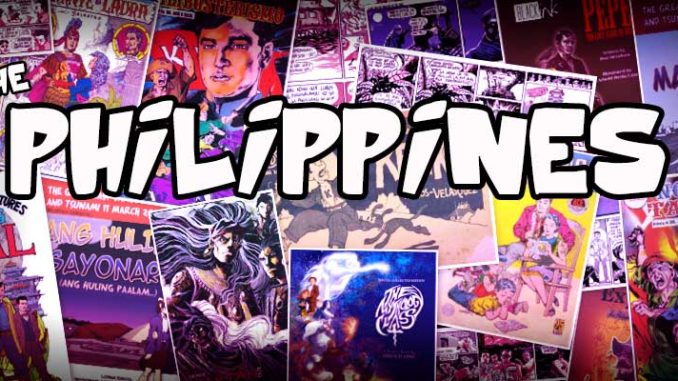
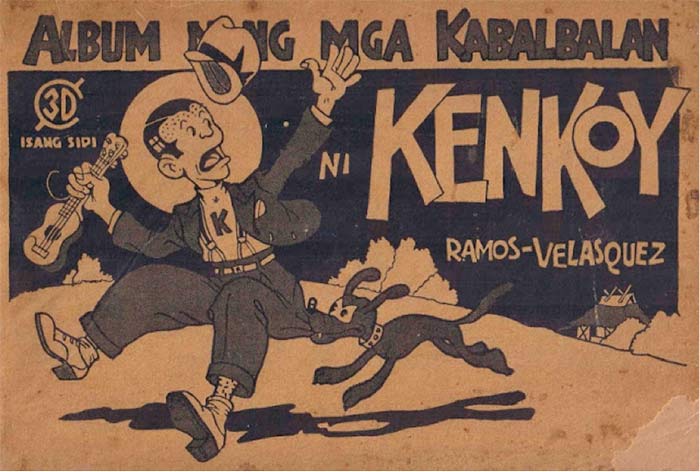
As cartoons were means to subtly criticize problems in society, komiks were seen as an affordable form of entertainment, which Filipinos consumed to escape workaday realities. However, Reyes noted that the predominant themes in komiks did not only relate to fantasy, but also included aspects of reality. The artists transformed the medium from something that provided laughs, to a sophisticated storytelling genre. From the 1930s to the 1980s various genres would be included in the repartee of komiks such as romance, science fiction, adult, effectively displacing Filipino literature such as myths, epics, novels, short stories, awit and corrido. The appeal of komiks did not only come from their affordability, but also in the language that was used and in the way that images complemented the texts (Reyes, 1985).

As the media matured, it expanded to include educational uses. After the period of the Japanese Occupation, artists began to create stories of the war. One of the earliest works was Antonio’s “Lakan Dupil: Ang Kahanga-hangang Gerilya” published in Liwayway Magazine on March 1947. Despite the fact that the series centers on fictional characters, the story is set during the Japanese Occupation and would deal with issues such as guerrilla activites, Kalibapi betrayals, and Kempeitai torture. Later, Ace Publications, Inc., the largest komik publishing firm in the Philippines, released its 6th title, Educational Klasiks. It began on 11 January 1960 with the intention of becoming a supplementary reading tool for private and public schools (Komiklopedia, 2007).
Despite the presence of these historical komiks, it would take time before readers began to properly use them for educational purposes. One of the earliest is Balagtas’ “Florante at Laura” adapted by Ped C. Tiangco and drawn by Mike C. Lombo in 1965 (Balagtas, 1965). These komiks would expand to Rizal’s novels “Noli Me Tangere” and “El Filibusterismo.” While the original novels were written in Spanish, the Noli was translated into Filipino and the Fili was translated to English (Rizal, Noli Me Tangere, 1961 and Rizal, El Filibusterismo, 1956). One intention of these works was to allow the larger populace to encounter these classical works as the komik versions were cheaper (priced between JPY 100 – 200 versus the novels which were JPY 1000 – 2000 each). Another intention was to stir the readers’ interest, and hopefully encourage them to read the original material. However, when one refers to the current use of educational komiks, these function as “cliffnotes” for young students who might not want to trawl through the archaic language of the original. The panel layouts and visual accompaniment allow the material to be manageable for students and thus leading to generations of students who know of the works without having read the original.
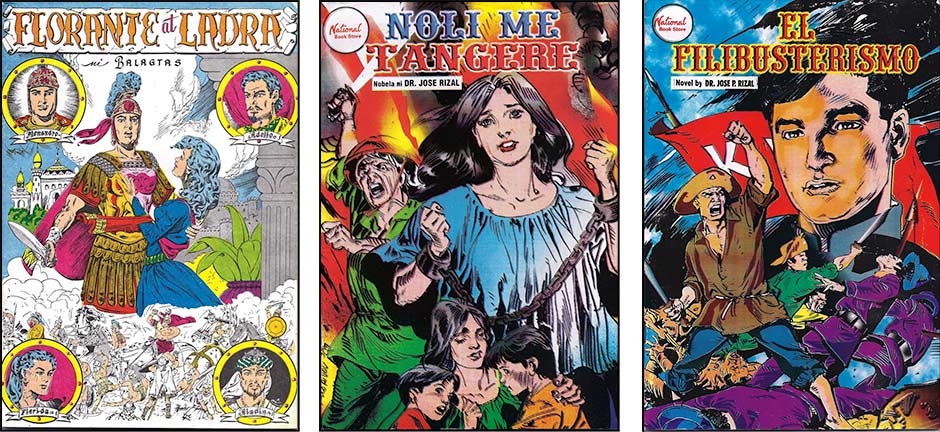
2— “Noli Me Tangere” adapted by Leo Miranda and D.G. Dumaraos and illustrated by R.M. Fabian
3— “El Filibusterismo” adapted by Grace R. Miranda and illustrated by R. M. Fabian
Another form of educational komiks are historical komiks, which introduce historical personalities to students. These function in the same way as the previous types, which allow students to get to know personalities and events in history without dealing with the oft “dry” materials of a typical textbook. Examples of this would be Coching’s “Lapu-Lapu” which was published as a 25-part serial published in Pilipino Komiks from November 1953 to September 1954, which was compiled and reprinted by Atlas Publishing in 2009 (Samar, 2013). National Bookstore would publish the “Filipino Heroes Comic Series” during the 1970s, featuring heroes such as Marcelo H. del Pilar, Datu Puti, and politicians such as Jose Abad Santos, Sergio Osmena, all of these were written by M. Franco. The popularity of the series encouraged another publisher, Merrian Webster to publish their own series written by Mario “Guese” Tungol in 1988.
Recently, a different form of educational komiks have been observed. One example would be Arre’s “Mythology Class” which, as the title suggests, works with Philippine mythologies. Arre used cultural concepts in a fictive setting, which engages the readers and encourages them to look deeper into the truth of the story. “Mythology Class” used mythical beings from folklore, and discusses how these beliefs were lost to time following the conversion to Catholicism. The series was initially published in 1999, and was compiled into a graphic novel in 2005. It was recognized with the National Book Awards under the category of Comicbooks by the Manila Critics Circle in 1999.
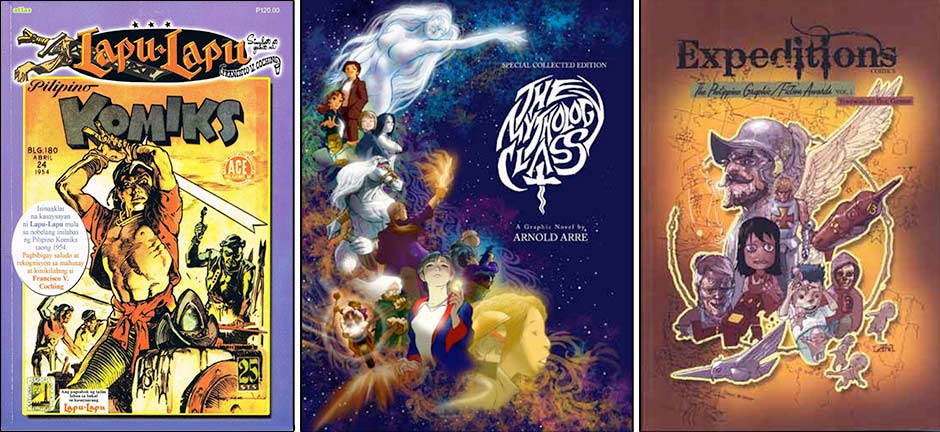
2— “The Mythology Class” by Arnold Arre
3— “Expeditions Comics: The Philippine Graphic/Fiction Awards Vol. 1,” edited by Neil Gaiman
This genre began to once again pick up, as the Battle of Mactan was re-interpreted into a comic by Juan Paolo Ferrer and Chester Ocampo in their work “Defiant: The Battle of Mactan” which would place third during the first Philippine Graphic/Fiction Awards. The Philippine Institute of Volcanology and Seismology (PHILVOLCS) with JICA-Manila produced komiks aimed towards disaster education featuring the stories of Filipina housewives who experienced the Great East Japan Earthquake and Tsunami.
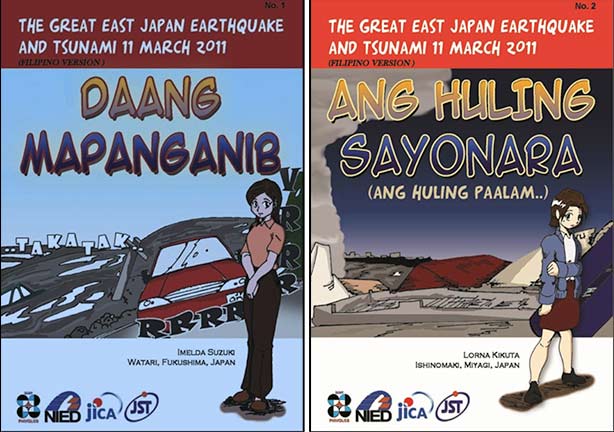
2— “Ang Huling Sayonara” by Lorna Kikuta
However, despite the success of these educational komiks, the genre was not actively used in schools as had been intended by the authors. While scholars such as Soledad Reyes and artists such as Gerry Alanguilan, recognized and wrote about the usefulness of komiks in education, it would take time before the education sector would consider using komiks.
This has not prevented artists from creating more educational komiks. A new komik book publisher, Black Ink Comics, released one title “Pepe: The Lost Years of Rizal” written by Ron Mendoza and situates a young Rizal in fictional narrative, while Gerry Alanguilan’s steampunk rendition is entitled “The Marvelous Adventures of the Amazing Dr. Jose Rizal” which he has been working on since 2007. Furthermore, Tepai Pascual reinterprets the story of Lapu-lapu in her work Maktan 1521.
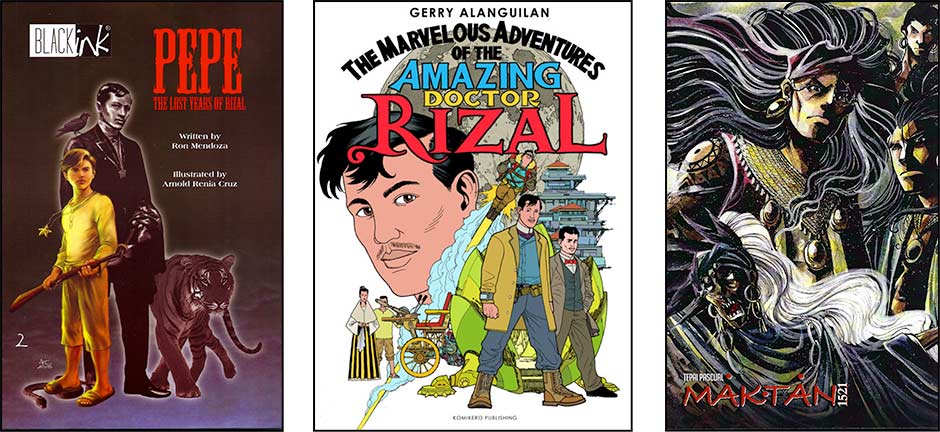
2— “The Marvelous Adventures of the Amazing Doctor Rizal” by Gerry Alanguilan
3— “Maktan 1521” by Tepai Pascual
Recently, an online komik entitled “Dead Balagtas” released komiks merging humor, historical events and popular cultural references. It was done by Emiliana Kampilan and the website is managed by friends Maria Lorenza and Vernice del Rosario. An interesting fact about this series is that it is undertaken by woman, which until recent years were a minority in the komiks’ scene. Furthermore, it pays homage to the roots of Philippine komiks by publishing non-sequitur gag komiks, similar to Kenkoy komiks. As the reader works through the series, one would notice the author’s irreverence to historical facts with her heavy use of popular cultural references. It seems that the works contain no educational value until the reader realizes that these references serve the purpose of making the events and personalities relatable for readership with little interest with Philippine history. The author’s comments would tempt her readers to further research on the events and personalities, especially if might do not understand the focus of a joke.
The scope of the series ranges from the Spanish Colonialism to the post-war period. Like most artists dealing with educational komiks, Rizal would be one of the historical personalities she would put to good use. During Rizal Day, December 29, 2013, she would parody Rizal’s struggle while operating his mother’s eyes. However, she would also write in the comments section that Rizal studied under Dr. Louis De Wecker and detail how he actually operated on his mother on two separate occasions (Kampilan, Rizal’s Super Advanced Surgery Skillz, 2013).

Another hero she would feature is Andres Bonifacio. She would illustrate the story of how Bonifacio and the Katipunan would seek the aid of the Japanese by requesting arms for their revolt against the Spanish. Unfortunately, for one reason or another, the purchase was unsuccessful. Aside from writing about events, she would briefly comment on Jose Moritaro Tagawa, the Japanese who helped in the negotiations for the arms (Kampilan, Ibang tulong ang kailangan namin Kongo, 2013).

Another popular theme would be World War II and the Japanese Occupation. An interesting feature is that she illustratea the touchy issue of how Filipinos betrayed fellow Filipinos during the period. Her use of Japanese popular culture, in the case of the February 2, 2014 strip, anime, would dilute the heaviness of the topic for the readers (Kampilan, Luis Taruc x Otaku, 2014).

Kampilan notes that one of her inspirations for her passion for history was her grandmother who was a historian, this might explain why she would also feature several historical women in her strips. She would have two strips on Felipa Culala, a Hukbalahap Squadron Commander (Kampilan, Showa Whitewash, 2013 and Kampilan, Abante Culala!, 2013). Another woman whom she would feature is Josefa Llanes Escoda, founder of the Girl Scouts of the Philippines, and an advocate of women’s suffrage. Escoda was known as the “Florence Nightingale of the Philippines” (Kampilan, Surgery Mano Mano, 2014). Finally, she would feature Marcela Marino de Agoncillo, Melchora Aquino, and Gabriela Silang.


A fascinating feature of the strips is her integration of literary works. One of her works makes a subtle reference to the Ilocano epic “Biag ni Lam-ang” (Kampilan, Untitled, 2013). She would also feature Rizal’s novels (Kampilan, Clara, Join the Darkside of the Force, 2014). She would suggest to her readers that if they cannot understand the strips, they should refer to the original works.
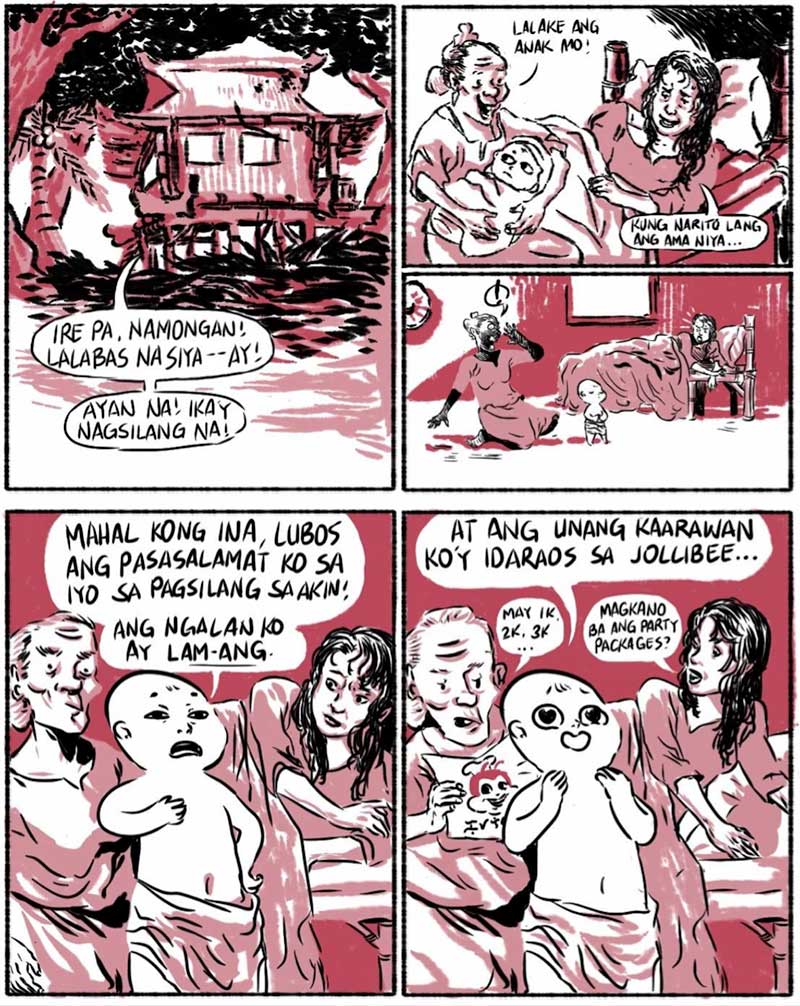
While naysayers may be critical of strips as having no depth, or even misleading her readers, the works were not intended to be 100% historically accurate. There was no intention of having these komiks used in the classroom, although the artist would be happy if this could happen. These komiks remind me of the bi-weekly column of Ambeth Ocampo in the Philippine Daily Inquirer, who gives readers a manageable portion of historical information to think about. Despite the sometimes criticisms against Ocampo for his “shoddy” research, he has a large reader base for his column. The readership spans people from all walks of life, and this has resulted in Filipinos thinking more about their history. Ocampo has made Philippine history accessible to everyone, and not just to scholars.

Kampilan does the same thing with her komiks. The komiks do not intimidate the reader with highly elaborate academic language. Rather, she uses a mixture of Filipino, English and slang in the dialogues of her komiks, an accessible combination which attracts readers to her work. Beyond the gags, the strips are created with much thought and research. This is why readers do not simply end the process with reading her strips, but her work leads to further thought and personal research.
Educational Komiks have gone a long way, and what we have seen is a series of changes in the development of these. While Kampilan’s Dead Balagtas is still in its infancy, it offers readers, and this reader particularly, a good deal of excitement and a glimpse towards how this genre will expand and improve in the future, both in their creation but also in their use.
Karl Ian Uy Cheng Chua
Karl Ian Uy Cheng Chua is Assistant Professor at the History Department,
Ateneo de Manila University, the Philippines
Kyoto Review of Southeast Asia. Issue 16 (September 2014) Comics in Southeast Asia: Social and Political Interpretations
Reference
Balagtas, F. (1965). Florante at Laura. (P. C. Tiangco, Trans.) (Quezon City: Manlapaz Publishing Company).
Kampilan, E. (2013, December 29). Rizal’s Super Advanced Surgery Skillz. Dead Balagtas. Philippines.
_____(2013, November 30). Ibang tulong ang kailangan namin Kongo. Dead Balagtas . Philippines.
_____(2014, February 2). Luis Taruc x Otaku. Dead Balagtas. Philippines.
_____(2013, October 28). Showa Whitewash. Dead Balagtas. Philippines.
_____(2013, November 9). Abante Culala! Dead Balagtas. Philippines.
_____(2014, January 26). Surgery Mano Mano. Dead Balagtas. Philippines.
_____(2013, August 22). Untitled. Dead Balagtas. Philippines.
Komiklopedia. (2007, April 8). Educational Klasiks. Retrieved January 30, 2014, from Snapshot from
Lent, J. (2004). From 1928 to 1993: The First 75 Years of Philippine Komiks.Comic Book Artist , 2 (4), pp. 74-95.
McCoy, A. W., & Roces, A. (1985). Philippine Cartoons: Political Caricature of the American Era, 1900-41. (Manila: Vera-Reyes).
Ocampo, A. (1990). Rizal: Father of Philippine Comics. In A. Ocampo, Rizal Without the Overcoat. (Pasig: Anvil Publishing).
Reyes, S. S. (1985). Romance and Realism in the Komiks. In J. Cynthia Roxas and Joaquin Arevalo, A History of Komiks of the Philippines and Other Countries (Quezon City: Islas Filipinas Publishing Co., Inc), pp. 47-52.
Rizal, J. P. (1956). El Filibusterismo. (G. R. Miranda, Trans.) (Mandaluyong National Book Store Publications).
_____(1961). Noli Me Tangere. (L. M. Dumaraos, Trans.) (Mandaluyong: National Book Store Publications).
Roxas, C., & Arevalo, J. J. (1985). A History of Komiks of the Philippines and Other (R. R. Marcelino, Ed.) (Quezon: Islas Filipinas Publishing Co., Inc.).
Samar, E. C. (2013, April 3). History and Heroism in Francisco V. Coching’s “Lapu-Lapu”. Retrieved January 31, 2014, from <http://www.goodreads.com/author_blog_posts/3969661-history-and-heroism-in-francisco-v-coching-s-lapu-lapu-1953-1954>.
Villegas, D. (2011, June 12). Jose Rizal: Komikero. Retrieved January 23, 2014, From <http://myrizal150.com/2011/06/jose-rizal-komikero/>.
